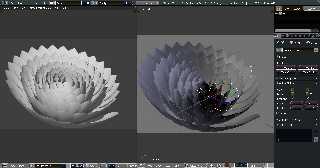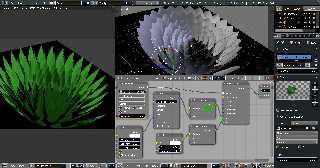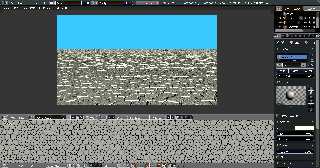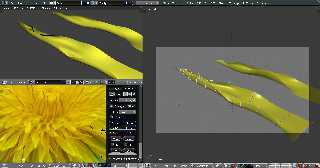 |
 |
|
 |
|
 |
|  |
|  |
|
 |
|
 |
|  |
|  |
|
 |
If I have correctly understood сlipka...
"Bald Eagle" <cre### [at] netscape net> wrote:
> "LanuHum" <Lan### [at] yandex net> wrote:
> "LanuHum" <Lan### [at] yandex ru> wrote:
>
> LanuHum, you are clearly a very talented and dedicated developer. While I have
> not used Blender (I downloaded it one 3 years ago, and felt like a child sitting
> in a fighter jet's cockpit...) I can see that your work has a lot of merit, and
> you always have very interesting, thought-provoking, and inspiring designs and
> accomplishments to share. :)
> Keep up the good work! I hope that you are enjoying yourself and having fun
> with your work. It is always good to see and makes me smile.
Thanks! :) But it is a pity what I know only Python programming language in
Blender. And, here I know not everything
> Are your plant and tree generations truly or pseudo-random, or is there some
> sort of Fibonacci based phyllotaxis embedded in the code?
>
> https://en.wikipedia.org/wiki/Phyllotaxis
My response to link:
Flower. 100 bicubic_patches. Default texture.
If to use image_map, pigment_pattern, UV, then it is possible to receive teeth ru> wrote:
>
> LanuHum, you are clearly a very talented and dedicated developer. While I have
> not used Blender (I downloaded it one 3 years ago, and felt like a child sitting
> in a fighter jet's cockpit...) I can see that your work has a lot of merit, and
> you always have very interesting, thought-provoking, and inspiring designs and
> accomplishments to share. :)
> Keep up the good work! I hope that you are enjoying yourself and having fun
> with your work. It is always good to see and makes me smile.
Thanks! :) But it is a pity what I know only Python programming language in
Blender. And, here I know not everything
> Are your plant and tree generations truly or pseudo-random, or is there some
> sort of Fibonacci based phyllotaxis embedded in the code?
>
> https://en.wikipedia.org/wiki/Phyllotaxis
My response to link:
Flower. 100 bicubic_patches. Default texture.
If to use image_map, pigment_pattern, UV, then it is possible to receive teeth
Post a reply to this message
Attachments:
Download 'flower.blend.jpg' (260 KB)
Preview of image 'flower.blend.jpg'

|
 |
|  |
|  |
|
 |
|
 |
|  |
|  |
|
 |
Use nodes of materials
Post a reply to this message
Attachments:
Download 'flower_image_pattern.blend.jpg' (411 KB)
Preview of image 'flower_image_pattern.blend.jpg'

|
 |
|  |
|  |
|
 |
|
 |
|  |
|  |
|
 |
Am 28.02.2016 um 19:42 schrieb LanuHum:
> If I have correctly understood сlipka...
It's "clipka", not "<cyrillic-s>lipka" ;)
But yeah - thanks a lot :)
BTW, I keep forgetting that your Blender-to-POV-Ray exporter is the
unofficial one, with all the work you've been putting into it.
Post a reply to this message
|
 |
|  |
|  |
|
 |
|
 |
|  |
|  |
|
 |
:)
Post a reply to this message
|
 |
|  |
|  |
|
 |
|
 |
|  |
|  |
|
 |
Paolo Gibellini <p.g### [at] gmail com> wrote:
> LanuHum wrote on 27/02/2016 13.14:
> > Polygons write as prism.
> > Very good result!
> >
> > Write, parse and render:
> > mesh as mesh: 4 minutes :(
> > mesh as prism: 20 seconds. :)
> >
> > the dried-up sea: 40 000 n-gons:
> >
> Great image!
> Now, a parameter to change slightly the heights of the prisms...
> ;-)
> Paolo com> wrote:
> LanuHum wrote on 27/02/2016 13.14:
> > Polygons write as prism.
> > Very good result!
> >
> > Write, parse and render:
> > mesh as mesh: 4 minutes :(
> > mesh as prism: 20 seconds. :)
> >
> > the dried-up sea: 40 000 n-gons:
> >
> Great image!
> Now, a parameter to change slightly the heights of the prisms...
> ;-)
> Paolo
Post a reply to this message
Attachments:
Download 'voronoi_big1.blend.jpg' (564 KB)
Preview of image 'voronoi_big1.blend.jpg'

|
 |
|  |
|  |
|
 |
|
 |
|  |
|  |
|
 |
On 03/03/2016 12:11 PM, LanuHum wrote:
> Paolo Gibellini <p.g### [at] gmail com> wrote:
>> LanuHum wrote on 27/02/2016 13.14:
>>> Polygons write as prism.
>>> Very good result!
>>>
>>> Write, parse and render:
>>> mesh as mesh: 4 minutes :(
>>> mesh as prism: 20 seconds. :)
>>>
>>> the dried-up sea: 40 000 n-gons:
>>>
>> Great image!
>> Now, a parameter to change slightly the heights of the prisms...
>> ;-)
>> Paolo
>
First, I think this prism feature quite neat! I see too from the bottom
ortho view that the voronoi is 2D - or effectively so.
Is the point set for the voronoi result point by point controllable in
Blender? In other words, are users able to define a set of points from
which the 2D/3D voronoi diagram is created?
Aside: I'd like such an ability in POV-Ray in addition to the strictly
random points used in the voronoi/crackle pattern we have today(1).
Bill P.
http://wiki.povray.org/content/User:Le_Forgeron#voronoi - with an input
point set. Though, I'd favor an extension to crackle over it so as to
have access to all the crackle options. com> wrote:
>> LanuHum wrote on 27/02/2016 13.14:
>>> Polygons write as prism.
>>> Very good result!
>>>
>>> Write, parse and render:
>>> mesh as mesh: 4 minutes :(
>>> mesh as prism: 20 seconds. :)
>>>
>>> the dried-up sea: 40 000 n-gons:
>>>
>> Great image!
>> Now, a parameter to change slightly the heights of the prisms...
>> ;-)
>> Paolo
>
First, I think this prism feature quite neat! I see too from the bottom
ortho view that the voronoi is 2D - or effectively so.
Is the point set for the voronoi result point by point controllable in
Blender? In other words, are users able to define a set of points from
which the 2D/3D voronoi diagram is created?
Aside: I'd like such an ability in POV-Ray in addition to the strictly
random points used in the voronoi/crackle pattern we have today(1).
Bill P.
http://wiki.povray.org/content/User:Le_Forgeron#voronoi - with an input
point set. Though, I'd favor an extension to crackle over it so as to
have access to all the crackle options.
Post a reply to this message
|
 |
|  |
|  |
|
 |
|
 |
|  |
|  |
|
 |
I like this surface feature a lot! Just try one more thing: that the
edges are kinda bend upwards slightly - then it would be like in
reality! And maybe some cracks on the sides, but only small cracks.
On 03.03.2016 12:11, LanuHum wrote:
> Paolo Gibellini <p.g### [at] gmail com> wrote:
>> LanuHum wrote on 27/02/2016 13.14:
>>> Polygons write as prism.
>>> Very good result!
>>>
>>> Write, parse and render:
>>> mesh as mesh: 4 minutes :(
>>> mesh as prism: 20 seconds. :)
>>>
>>> the dried-up sea: 40 000 n-gons:
>>>
>> Great image!
>> Now, a parameter to change slightly the heights of the prisms...
>> ;-)
>> Paolo
> com> wrote:
>> LanuHum wrote on 27/02/2016 13.14:
>>> Polygons write as prism.
>>> Very good result!
>>>
>>> Write, parse and render:
>>> mesh as mesh: 4 minutes :(
>>> mesh as prism: 20 seconds. :)
>>>
>>> the dried-up sea: 40 000 n-gons:
>>>
>> Great image!
>> Now, a parameter to change slightly the heights of the prisms...
>> ;-)
>> Paolo
>
Post a reply to this message
|
 |
|  |
|  |
|
 |
|
 |
|  |
|  |
|
 |
Do you have the source code available for us? I would love to experiment
with such a surface. Making it sand.brown and dusty...
On 03.03.2016 12:11, LanuHum wrote:
> Paolo Gibellini <p.g### [at] gmail com> wrote:
>> LanuHum wrote on 27/02/2016 13.14:
>>> Polygons write as prism.
>>> Very good result!
>>>
>>> Write, parse and render:
>>> mesh as mesh: 4 minutes :(
>>> mesh as prism: 20 seconds. :)
>>>
>>> the dried-up sea: 40 000 n-gons:
>>>
>> Great image!
>> Now, a parameter to change slightly the heights of the prisms...
>> ;-)
>> Paolo
> com> wrote:
>> LanuHum wrote on 27/02/2016 13.14:
>>> Polygons write as prism.
>>> Very good result!
>>>
>>> Write, parse and render:
>>> mesh as mesh: 4 minutes :(
>>> mesh as prism: 20 seconds. :)
>>>
>>> the dried-up sea: 40 000 n-gons:
>>>
>> Great image!
>> Now, a parameter to change slightly the heights of the prisms...
>> ;-)
>> Paolo
>
Post a reply to this message
|
 |
|  |
|  |
|
 |
|
 |
|  |
|  |
|
 |
Sven Littkowski <jam### [at] yahoo com> wrote:
> Do you have the source code available for us? I would love to experiment
> with such a surface. Making it sand.brown and dusty...
>
Yes, please!
:) com> wrote:
> Do you have the source code available for us? I would love to experiment
> with such a surface. Making it sand.brown and dusty...
>
Yes, please!
:)
Post a reply to this message
Attachments:
Download 'data_prismes_dec.7z.zip' (1871 KB)
|
 |
|  |
|  |
|
 |
|
 |
|  |
|  |
|
 |
http://cvetikof.ru/uploads/posts/2012-01/1326886064_3_med.jpg
I didn't find the link to a flower which used in a background.
Lobes above have difficult geometry.
It is possible to model 100 - 1000 such lobes using armatures (bones).
Post a reply to this message
Attachments:
Download 'dandelion.blend.jpg' (274 KB)
Preview of image 'dandelion.blend.jpg'

|
 |
|  |
|  |
|
 |
|
 |
|  |




![]()